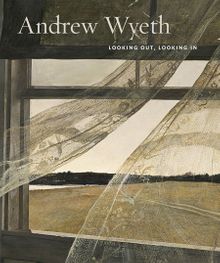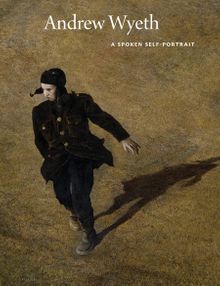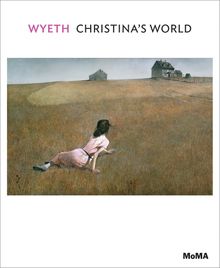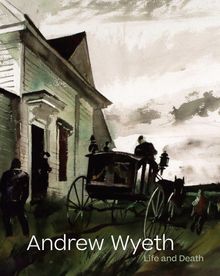| |||||||||||||||||||||||||
ARTIST MONOGRAPHS
|
|
in stock $45.00 Free Shipping UPS GROUND IN THE CONTINENTAL U.S. |
 Andrew Wyeth: Looking Out, Looking In
Andrew Wyeth: Looking Out, Looking In
Published by D.A.P..
Text by Nancy K. Anderson, Charles Brock.
Published with National Gallery of Art, Washington.
One of Andrew Wyeth's most important paintings, "Wind from the Sea" (1947), is also the artist's first full realization of the window as a recurring subject in his art. Wyeth returned to windows during the course of the next 60 years, producing more than 300 remarkable works that explore both the formal and conceptual richness of the subject. Absent from these spare, elegant, almost abstract paintings is the narrative element inevitably associated with Wyeth's better-known figural compositions. In 2014 the National Gallery of Art, Washington, presents an exhibition of a select group of these deceptively realistic works, window paintings that are in truth skillfully manipulated compositions centering on the visual complexities posed by the transparency, beauty and formal structure of windows. In its exclusive focus on paintings without human subjects, this catalogue offers a new approach to Wyeth's work and represents the first time that his non-figural works have been published as a group since the 1990s.The authors explore Wyeth's fascination with windows--their formal structure and metaphorical complexity. In essays that address links with the poetry of Robert Frost and the paintings of Edward Hopper, Charles Sheeler and other artistic peers, the authors consider Wyeth's statement that he was, in fact, an abstract painter.American painter Andrew Wyeth (1917-2009) lived his entire life in his birthplace of Chadds Ford, Pennsylvania, and his summer home in mid-coast Maine. His seven-decade career was spent painting the land and people that he knew and cared about. Renowned for his tempera "Christina's World" (1948), Wyeth navigated between artistic representation and abstraction in a highly personal way.
PUBLISHER
D.A.P.
BOOK FORMAT
Clth, 10 x 11 in. / 216 pgs / 150 color.
PUBLISHING STATUS
Pub Date 5/31/2014
Out of stock indefinitely
DISTRIBUTION
D.A.P. Exclusive
Catalog: SPRING 2014 p. 7
PRODUCT DETAILS
ISBN 9781938922190 TRADE
List Price: $55.00 CAD $72.50
AVAILABILITY
Not available
STATUS: Out of stock indefinitely. |
 Andrew Wyeth: A Spoken Self-Portrait
Andrew Wyeth: A Spoken Self-Portrait
Selected and Arranged by Richard Meryman from Recorded Conversations with the Artist, 1964-2007
Published by D.A.P..
Published with National Gallery of Art, Washington.
Richard Meryman began an enduring friendship with Andrew Wyeth (1917–2009) while on the job as a Life magazine editor in 1964. For Meryman, this unique friendship yielded more than four decades of recorded conversations with Wyeth, his family, friends and neighbors in Wyeth's homes in Pennsylvania and Maine. Meryman notes that, whether during formal interviews, shared meals, car rides or long walks, "Wyeth applied to himself the same sensitive understandings that fueled his art. A lifelong realist who swam against the art world tide of modernism, he showed himself to be fundamentally a painter of emotion--of people and objects that somehow embodied his memories and imagination, triggering feelings inexpressible in words, but recognized by viewers." In five skillfully crafted monologues composed by Meryman around key themes in Wyeth's work, we hear the voices of not only the artist but also his subjects, neighbors, relatives and critics. The book includes reproductions of the works of art discussed by Wyeth in his own words, as well as previously unpublished photographs of Wyeth's studio taken in 2009.
Richard Meryman is the author of the acclaimed biography Andrew Wyeth: A Secret Life (1996).
PUBLISHER
D.A.P.
BOOK FORMAT
Hardcover, 7.5 x 9.75 in. / 128 pgs / 75 color.
PUBLISHING STATUS
Pub Date 10/31/2013
Out of stock indefinitely
DISTRIBUTION
D.A.P. Exclusive
Catalog: FALL 2013 p. 11
PRODUCT DETAILS
ISBN 9781938922183 TRADE
List Price: $29.95 CAD $39.95
AVAILABILITY
Not available
STATUS: Out of stock indefinitely. |
 Andrew Wyeth: Christina’s World
Andrew Wyeth: Christina’s World
MoMA One on One Series
Published by The Museum of Modern Art, New York.
Text by Laura Hoptman.
PUBLISHER
The Museum of Modern Art, New York
BOOK FORMAT
Paperback, 7.25 x 9 in. / 48 pgs / 35 color.
PUBLISHING STATUS
Pub Date 7/31/2012
Out of print
DISTRIBUTION
D.A.P. Exclusive
Catalog: SPRING 2012 p. 51
PRODUCT DETAILS
ISBN 9780870708312 TRADE
List Price: $14.95 CAD $21.00
AVAILABILITY
Not available
STATUS: Out of print | 00/00/00 For assistance locating a copy, please see our list of recommended out of print specialists |
